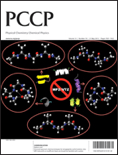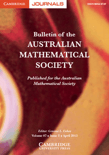
JOURNAL OF MATHEMATICAL CHEMISTRY
Scope & Guideline
Pioneering Research at the Nexus of Math and Chemistry
Introduction
Aims and Scopes
- Graph Theory in Chemistry:
The journal extensively covers the application of graph theory to solve problems related to chemical structures, such as the study of topological indices, connectivity indices, and graph energies. - Computational Chemistry:
Papers frequently explore computational methods and models that aid in understanding chemical phenomena, including quantum chemistry and reaction kinetics. - Mathematical Modeling of Chemical Systems:
The journal publishes research that formulates mathematical models to describe chemical reactions and processes, including fractional calculus and differential equations. - Topological Indices and Molecular Descriptors:
A significant focus is placed on the development and analysis of topological indices, which are used to correlate molecular structure with chemical properties. - Applications in Nanotechnology and Material Science:
The journal addresses applications of mathematical chemistry in nanostructures and advanced materials, highlighting the intersection of mathematical models with practical chemistry.
Trending and Emerging
- Fractional Calculus in Chemical Modeling:
There is a growing interest in using fractional calculus to model complex chemical systems, reflecting a trend towards more sophisticated mathematical tools that can capture non-integer order dynamics. - Graph Energies and Their Applications:
Research on graph energies has gained traction, with studies exploring their applications in characterizing molecular properties, indicating a trend towards integrating energy concepts in chemical graph theory. - Advanced Computational Techniques:
The use of novel computational techniques, such as quantum perturbation theory and advanced algorithms for topological indices, is on the rise, emphasizing the journal’s focus on innovative computational approaches. - Applications in Nanostructures and Materials Science:
A marked increase in research related to nanostructures and material science is evident, showcasing the journal's relevance to current technological advancements and interdisciplinary applications. - Interdisciplinary Approaches:
There is a trend towards interdisciplinary research that combines insights from different scientific domains, such as physics, biology, and materials science, with mathematical chemistry, reflecting broader scientific collaborations.
Declining or Waning
- Classical Chemical Graph Theory:
There has been a noticeable decline in the publication of papers focusing solely on classical aspects of chemical graph theory without novel applications or methodologies. - Traditional Chemical Kinetics:
Papers solely dedicated to traditional chemical kinetics, without the integration of advanced mathematical approaches or computational methods, have become less frequent. - Basic Topological Indices without Novel Insights:
The exploration of well-established topological indices without new insights or applications has waned, as researchers increasingly seek innovative contributions that provide deeper understanding.
Similar Journals

MATCH-COMMUNICATIONS IN MATHEMATICAL AND IN COMPUTER CHEMISTRY
Pioneering Research at the Crossroads of Chemistry and ComputationMATCH-COMMUNICATIONS IN MATHEMATICAL AND IN COMPUTER CHEMISTRY, published by the University of Kragujevac, Faculty of Science, stands at the intersection of mathematical theories and computational applications within the field of chemistry. This esteemed journal, recognized for its contributions to applied mathematics and miscellaneous chemistry, boasts impressive Scopus rankings, being placed in the Q1 quartile for both applied mathematics and miscellaneous chemistry, as well as achieving significant rankings in computational theory and computer science applications. With an enduring history since 1990 and continuing through 2025, MATCH not only serves as a pivotal platform for scholarly communication but also aims to bridge the gap between theoretical research and practical application. This journal is essential for researchers, professionals, and students seeking to push the boundaries of knowledge in these dynamic fields.

Russian Journal of Physical Chemistry A
Exploring the Frontiers of Physical ChemistryWelcome to the Russian Journal of Physical Chemistry A, a prominent publication in the field of Physical and Theoretical Chemistry, published by MAIK NAUKA/INTERPERIODICA/SPRINGER. This journal, with ISSN 0036-0244 and E-ISSN 1531-863X, has been a vital platform for disseminating significant research findings since its inception in 1996. As a key contributor to academic discourse, it aims to provide high-quality articles that explore fundamental and applied aspects of physical chemistry, thereby enhancing understanding and innovation in the discipline. Although currently categorized as Q4 by Scopus (2023), the journal is positioned to evolve with the scholarly landscape, continually striving to improve its impact and relevance. With no open access options available, subscription to this journal is essential for those keen on enriching their knowledge and staying current with advancements in physical chemistry. Researchers, professionals, and students alike will find invaluable insights and robust discussions that can inspire their work and studies.

Acta Mathematica Universitatis Comenianae
Empowering minds with comprehensive insights into mathematics.Acta Mathematica Universitatis Comenianae is a distinguished journal dedicated to advancing the field of mathematics, particularly in its miscellaneous branches. Published by Comenius University in Slovakia, this journal provides a vital platform for researchers and scholars to disseminate their findings and engage with contemporary mathematical discourse. Despite being categorized in the fourth quartile for 2023 in general mathematics within Scopus, the journal plays an essential role in fostering academic dialogue and contributing to regional developments in mathematical research. The journal's scope includes a wide array of topics, ensuring contributions from various domains of mathematics are encouraged. With its commitment to publishing quality research, Acta Mathematica Universitatis Comenianae is an invaluable resource for professionals, students, and academics seeking to expand their knowledge and engage with a community of its peers.

Computational and Theoretical Chemistry
Exploring the Nexus of Theory and ComputationComputational and Theoretical Chemistry, published by ELSEVIER, stands at the forefront of interdisciplinary research in the realms of computational chemistry, theoretical physics, and biochemistry. With its ISSN 2210-271X and E-ISSN 1872-7999, the journal has established a significant presence in the academic community since its inception. Covering innovative computational methodologies and theoretical advancements, it addresses critical issues in condensed matter physics and molecular biochemistry, providing a rich resource for scholars and industry professionals alike. The journal enjoys a respectable impact factor and ranks notably in several Scopus categories, making it a vital platform for disseminating high-quality research. It adopts an open-access model, facilitating wider readership and engagement, which is essential for fostering collaborative innovations in the scientific landscape. As it continues to evolve from 2011 to 2024, Computational and Theoretical Chemistry is committed to advancing knowledge and promoting insightful discussions within the scientific community.

PHYSICAL CHEMISTRY CHEMICAL PHYSICS
Illuminating the Path to Breakthroughs in Chemical PhysicsPhysical Chemistry Chemical Physics is a premier interdisciplinary journal published by the Royal Society of Chemistry, dedicated to advancing the fields of physical chemistry and chemical physics. With an impressive impact factor and categorized in the Q2 quartiles for both Physical and Theoretical Chemistry and Physics and Astronomy, this journal serves as a vital platform for the dissemination of high-quality research findings from 1999 through 2024. Based in the United Kingdom, the journal is committed to providing open access to its articles, enhancing the visibility and accessibility of research to a global audience. Researchers, professionals, and students alike are encouraged to contribute to this esteemed journal, ensuring impactful discussions and significant advancements in the understanding of chemical and physical phenomena. With strong Scopus rankings underscoring its relevance, Physical Chemistry Chemical Physics stands out as an essential resource for specialists striving to innovate and excel within these dynamic fields.

Physical Chemistry Research
Unveiling new methodologies in fluid flow and transfer processes.Physical Chemistry Research, published by the Iranian Chemical Society, is an esteemed academic journal dedicated to advancing knowledge within the fields of *Fluid Flow and Transfer Processes*, *Physical and Theoretical Chemistry*, and *Statistical and Nonlinear Physics*. Since its inception in 2013, the journal has established a crucial platform for researchers, professionals, and students to share innovative findings and methodologies, enhancing collaboration and knowledge dissemination in the physical chemistry community. With impactful contributions recognized in Quartile 3 and Quartile 4 classifications across various categories, the journal is positioned to cultivate emerging research trends as it continues to converge through 2024. Researchers can benefit from diverse perspectives on crucial phenomena in physical chemistry, as the journal is indexed in prominent databases, further increasing accessibility and visibility. The *open access* policy ensures that cutting-edge research remains available to a broad audience, promoting the growth of the discipline globally.

Punjab University Journal of Mathematics
Elevating the discourse of theoretical and applied mathematics.Punjab University Journal of Mathematics is a prestigious academic journal published by the Department of Mathematics at the University of Punjab, Pakistan. Dedicated to advancing the field of mathematics, this journal provides a platform for researchers, educators, and students to disseminate their findings, foster scholarly dialogue, and promote innovative mathematical research. With a strong focus on theoretical and applied mathematics, the journal maintains a rigorous peer-review process to ensure high-quality publications that significantly contribute to the mathematical community. Although currently not indexed in prominent databases, the journal aims to elevate its visibility and impact through consistent publication of cutting-edge research. The absence of Open Access reflects a commitment to quality and thorough review, but researchers are encouraged to seek out this valuable resource for its insights and diverse contributions to mathematics.

European Journal of Pure and Applied Mathematics
Empowering Research through Innovative Mathematical DiscoveriesThe European Journal of Pure and Applied Mathematics, published by NEW YORK BUSINESS GLOBAL LLC, stands as a pivotal platform in the mathematical sciences, fostering the dissemination of significant research across various domains including algebra, applied mathematics, geometry, and theoretical computer science. Since embracing Open Access publishing in 2011, the journal enables unparalleled access to innovative findings and methodologies, making it an invaluable resource for researchers, professionals, and students alike. With a commendable Scopus ranking and a demonstrated impact within its categories—holding a Q3 position in several mathematical disciplines—the journal reflects a commitment to advancing knowledge and facilitating scholarly dialogue.

BULLETIN OF THE AUSTRALIAN MATHEMATICAL SOCIETY
Advancing Mathematical Frontiers Since 1969BULLETIN OF THE AUSTRALIAN MATHEMATICAL SOCIETY is an esteemed journal dedicated to advancing the field of mathematics, published by Cambridge University Press. Since its inception in 1969, this periodical has fostered scholarly communication and showcased pivotal research in various domains of mathematics, now projected to continue until 2024. With an impact factor that places it in the Q2 category of miscellaneous mathematics research, it holds a notable position among its peers, ranking 215th out of 399 in the Scopus database. Though it does not currently offer open access options, the journal remains a vital resource for researchers, professionals, and students seeking to deepen their understanding of mathematical advancements. The Bulletin serves as a crucial platform for disseminating original research, comprehensive reviews, and insightful perspectives that navigate the complexities of mathematics today, ensuring the community is well-informed and engaged.

ACTA CHIMICA SLOVENICA
Empowering Discoveries in the Heart of SloveniaACTA CHIMICA SLOVENICA is a distinguished peer-reviewed journal dedicated to advancing the field of chemistry, published by the SLOVENSKO KEMIJSKO DRUSTVO. With an ISSN of 1318-0207 and E-ISSN 1580-3155, this journal has been an essential resource for researchers and professionals since its inception in 1996. Recognized for its commitment to open access since 1998, it fosters global collaboration by making research widely available. Based in Slovenia, the journal operates with a focus on various domains within chemistry, achieving a respectable Q3 ranking in 2023 within the miscellaneous chemistry category on Scopus, showcasing its impact and relevance. This journal serves as a vital platform for innovative research, reviews, and discoveries, aiming to enhance knowledge and ignite curiosity in a diverse readership, including students and emerging scholars in the field.